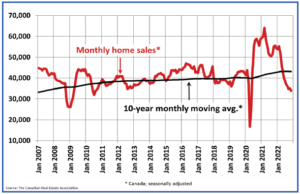The Bank of Canada is widely expected to raise its benchmark rate yet again on Dec. 7
Mortgage brokers say homeowners with variable-rate mortgages will be squeezed even further next week, as the Bank of Canada is widely expected to raise the country’s key lending rate as part of its continued efforts to curb rapidly rising inflation.
The rate adjustment is scheduled for Dec. 7, and if it happens the way most are predicting, it will be the seventh such hike in the prime rate since March.
Variable rate mortgages, where payments are linked to the rise and fall of the country’s key lending rate, account for about a third of all mortgage debt in the country, according to the Bank of Canada.
They grew in popularity during the COVID-19 pandemic, as housing prices soared while interest rates were close to zero — keeping many buyers’ payments significantly lower than if they were to choose a fixed-rate mortgage.
Now that interest rates are rising, and home prices are falling, many homeowners who bought at the market’s peak have found themselves questioning whether they made the right choice and if it’s not too late to make a change.
‘Should I lock in?’ There’s no easy answer
“Should I lock in? That’s the million dollar question right now, and it’s a tough question to answer,” said Dani Hanna, a mortgage broker and owner of the Mortgage Firm in London, Ont.
“The reason the rates have been increasing so quickly is because of inflation. Inflation is through the roof. We could see that start to subside in the next couple of months, and if that starts to subside, could we see interest rates go down? Possibly,” he said.
It’s why some mortgage brokers are reticent to advise their clients to lock in now at a fixed rate.
If inflation starts to slow, the central bank could lower rates again, bringing payments down with them. If a homeowner were to switch to a fixed rate, they could be stuck paying significantly more than they would have if they just kept a variable rate, Hanna said.
“For me, I ask my clients, ‘is this keeping you up at night? Are you stressed out about the fact that your payment can increase again?’ If the answer is ‘yes,’ then I strongly recommend locking into the fixed rate,” he said.
“If you have the ability to maintain these higher payments for now — ride the wave. See what happens. The Bank of Canada has mentioned that it has started to slow down on the increases, which means your payment won’t go up”
Half of all variable rate mortgages hit trigger rate in October
Part of the reason is that many borrowers are reaching the point where the interest portion of their payment has become larger than the principal, called the trigger rate.
A recent analysis by the Bank of Canada estimated half of all variable rate mortgages in Canada hit their trigger rate last month.
The analysis said it is anticipated “variable mortgage rates will increase by another 50 basis points by mid-2023.” At that point, it’s believed the number of variable rate mortgages to hit their trigger point will be 65 per cent, or 17 per cent of all mortgages in Canada.
In London, Ont., the average price of a home has fallen for eight months to roughly $640,000 in October, down from the market’s peak of about $825,000 in February.
“It’s tough,” said Mark Mitchell, a London, Ont., mortgage broker with Real Mortgage Associates. “Rates have gone sky-high.”
Like many financial experts, Mitchell anticipates a hike of at least 50 basis points on Dec. 7, putting the Bank of Canada prime rate at 4.25 per cent. He believes there are more to come, putting homeowners who chose variable rate mortgages in an even more difficult position.
“The prime rate is 3.75 and the inflation rate is seven. Historically, the prime rate is supposed to be higher than inflation. Now I don’t think they’re going to go that far, but they still have a ways to go.
“All signs point to it’s going to get worse before it gets better.”
Mitchell said he’s advising borrowers with a variable rate mortgage to lock in now to avoid even more pain down the road, but if a client can’t afford to lock in because the payments are too high, he said it might be time to consider selling.
“I’m already seeing a lot of anticipatory selling because it’s too high for them to lock in,” he said. “There’s a lot of pain out there. It’s been a lot of tough conversations as of late, that’s for sure.”
Mitchell said many people who are considering selling a home they can’t keep are looking at renting, but they likely won’t see any relief there as rental rates also rose alongside real estate prices during the frenzy of the pandemic.
“The payments are just as high as you were paying, if not more, than when you owned your home, unfortunately.”
Source CBC.ca
Colin Butler
https://www.cbc.ca/news/canada/london/variable-rate-mortgage-interest-1.6667899



